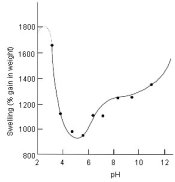I just like that there's something called a "swellometer." Do you have a picture of one?
David;
Kodak built their own and they don't match anything commercially available.
Basically, there was a 1" square well with a dam around it. A lever with a circular plate was lowered gently onto the photo material being tested, and thickness was measured.
Then the head was raised just a mm or so, and the well was infused with the solution being tested. The plate was dropped immediately and a timer was started as well as a strip chart recorder. This measured initial thickness and then thickness as a function of time. The test was continued until the swell had stabilzed.
The dam could be raised to dump the solution and the next processing step could then be carried out.
The attached is a commercial swell test posted on the internet. It tracks the gain in weight vs pH using bone gelatin. If you flip the graph on the horizontal axis (but not the pH scale), you get an approximate plot of the swell behavior of pig gelatin vs pH. If you read the scale from right to left, you see an approximate plot of swell for B&W materials during processing, and if you imagine a roughly straight line, you have a B&W material developed, rinsed and then fixed in TF-4. The swell pretty much stays at its maximum level.
PE







